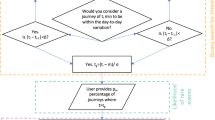Abstract
It is argued that an understanding of variability is central to the modelling of travel behaviour and the assessment of policy impacts, and is not the peripheral issue that it has often been considered. Drawing on recent studies in the UK and Australia, in conjunction with a review of the literature, the paper first examines the policy and analytical rationale for using multi-day data, then illustrates different ways of measuring variability, and finally discusses issues relating to the collection of suitable data for such analyses.
In a policy context, there is a growing need for multi-day data to examine issues that affect general rather than one-day behaviour (e.g. to assess the distribution of user charges for road pricing, or patterns of public transport usage); while analytically, multi-day data is needed to improve our ability to identify the mechanisms behind travel behaviour and to derive better empirical relationships.
Three measures of variability are presented: a graphical form showing daily differences in behaviour at the individual level; an aggregate, similarity index; and a hybrid graphical/numerical measure, which provides new insights into variability in daily patterns of behaviour.
The paper raises a number of issues for debate, probably the most crucial of which is: variability in what? The way in which behaviour is measured crucially affects our conception of stability and variability.
Similar content being viewed by others
References
Appleby, L. & P. Jones (1985) Investigating the consequences of different levels of bus service provision: A preliminary analysis using National Travel Survey (1978/79) data. Report to TRRL Transport Studies Unit ref. 278
Atkins, S. (1983) Experience from a repeated travel survey. Paper presented to the University Transport Study Group Conference, January
Barnard, P.O. (1984) Use of an activity diary survey to examine travel and activity reporting in a home interview survey (pp. 273-302). Proceedings ATRF Conference, Adelaide, May 1984
Bonsall, P. & F. Montgomery (1984) Bias and error in estimates of the day-to-day variability in driver behaviour. Paper presented to the Transportation Planning Methods Stream, PTRC Summer Annual Meeting, July
Brog, W., K. Fallast, H. Katteler, G. Sammer & B. Schwertner (1985) Selected results of a standarised survey instrument for large-scale travel surveys in several European countries. In: E. Ampt, A. Richardson & W. Brog (Eds) New Survey Methods in Transport. VNU Science Press, Utrecht
Clarke, M., M. Dix & P. Jones (1981) Error and uncertainty in travel surveys. Transportation 10: 105–126
Dix, M. & A. Layzell (1986) Behaviour changes in changing populations: problems and proposals for policy directed longitudinal studies. In: Ministry of Transport and Public Works (Ed) Behavioural Research for Transport Policy. VNU Science Press, Utrecht
Godard, X. (1983) Presentation of some results of the Dijon survey: linkage between activities and mobility. In: S. Carpenter & P. Jones (Eds) Recent Advances in Travel Demand Analysis. Chapter 8. Gower, Aldershot
Golob, T.F. & H. Meurs (1986) Biases in response over time in a seven-day travel diary. Transportation 13: 163–181
Goodwin, P. (1978) Intensity of car use in Oxford. In: Traffic Engineering and Control (pp. 514–517) November 1978
Gunn, H. & H. Pol (1986) Model transferability: the potential for increasing cost effectiveness. In: Ministry of Transport and Public Works (Ed) Behavioural Research for Transport Policy. VNU Science Press, Utrecht
Hanson, S. & J. Huff (1982) Assessing day-to-day variability in complex travel patterns. Transportation Research Record 891: 18–24
Hanson, S. & J. Huff (1986) Classification issues in the analysis of complex travel behaviour. Transportation 13: 271–293
Harrison, B. (1986) Electronic road pricing in Hong Kong: estimating and evaluating the benefits. Traffic Engineering and Control, January 1986, pp. 13–18
Herz, R. (1983) Stability, variability and flexibility in everyday behaviour. In: S. Carpenter & P. Jones (Eds) Recent Advances in Travel Demand Analysis, Chapter 20. Gower, Aldershot
Huff J & S. Hanson (1986) Repetition and variability in urban travel. Geographical Analysis 18: 97–114
Jones, P., M. Clarke & M. Dix (1986a) Household Activity-Travel Patterns in Adelaide: Stage 1B report. Director-General of Transport South Australia
Jones, P., M. Clarke & L. Oxlad (1986b) Investigating household activity-travel patterns in Adelaide. Paper presented to the Australian Transport Research Forum Conference, Darwin, May 1986
Koppelman, F. & E. Pas (1984) Estimation of disaggregate regression models of person trip generation with multi-day data. In: J. Volmuller & R. Hamerstag (Eds.) Proceedings, International Symposium on Transportation and Traffic Theory. VNU Science Press, Utrecht
Pas, E. (1986) Multiday samples, parameter estimation precision and data collection costs for least squares regression trip generation models. Environment and Planning A 18: 73–87
Pas, E. & F. Koppelman (1986) An examination of the determinants of day-to-day variability in individuals' urban travel behaviour. Transportation 13: 183–200
Recker, W., M. McNally & G. Root (1983) Application of pattern recognition theory to activity pattern analysis. In: S. Carpenter & P. Jones (Eds) Recent Advances in Travel Demand Analysis, Chapter 23. Gower, Aldershot
Smart, H. E. (1984) The dynamics of change-applications of the Panel Technique to transportation surveys in Tyne and Wear. Tragic Engineering and Control, December: 595–598
Stopher, P. & I. Sheskin (1982) Toward improved collection of 24–8 travel records. Transportation Research Record 891: 10–17
Waschke, T. (1984) Influences on changing travel behaviour. Paper presented at the PTRC Summer Annual Meeting, Seminar H, July
Author information
Authors and Affiliations
Rights and permissions
About this article
Cite this article
Jones, P., Clarke, M. The significance and measurement of variability in travel behaviour. Transportation 15, 65–87 (1988). https://doi.org/10.1007/BF00167981
Issue Date:
DOI: https://doi.org/10.1007/BF00167981




